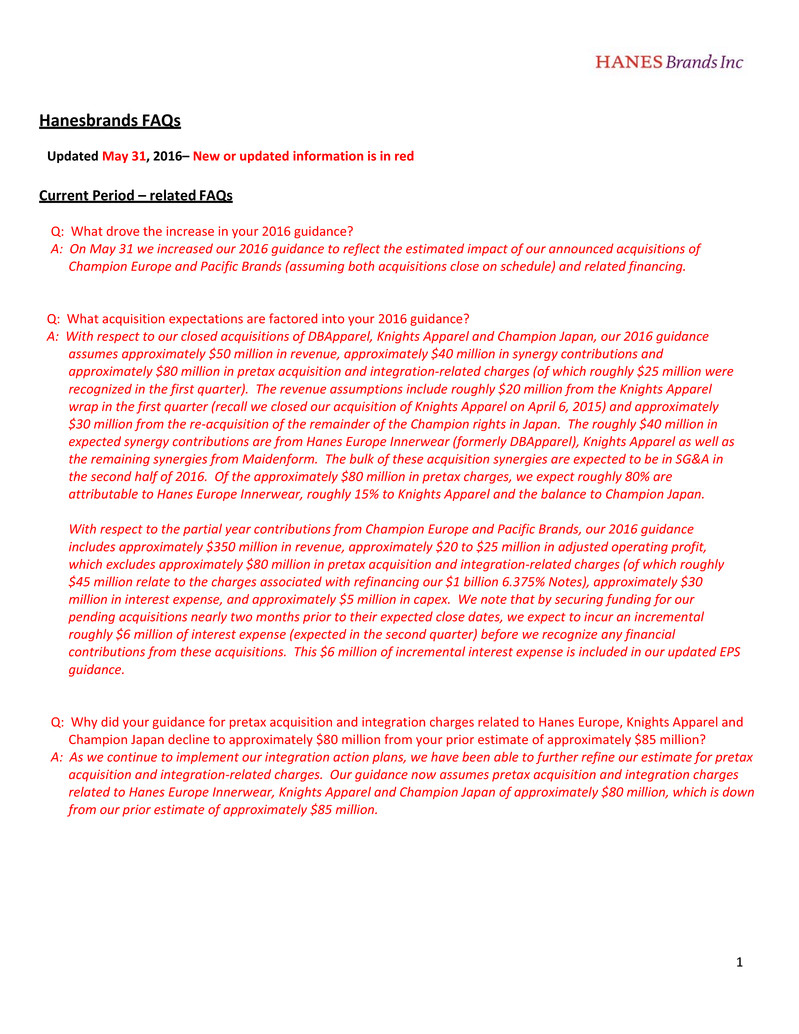
1 Hanesbrands FAQs Updated May 31, 2016– New or updated information is in red Current Period – related FAQs Q: What drove the increase in your 2016 guidance? A: On May 31 we increased our 2016 guidance to reflect the estimated impact of our announced acquisitions of Champion Europe and Pacific Brands (assuming both acquisitions close on schedule) and related financing. Q: What acquisition expectations are factored into your 2016 guidance? A: With respect to our closed acquisitions of DBApparel, Knights Apparel and Champion Japan, our 2016 guidance assumes approximately $50 million in revenue, approximately $40 million in synergy contributions and approximately $80 million in pretax acquisition and integration‐related charges (of which roughly $25 million were recognized in the first quarter). The revenue assumptions include roughly $20 million from the Knights Apparel wrap in the first quarter (recall we closed our acquisition of Knights Apparel on April 6, 2015) and approximately $30 million from the re‐acquisition of the remainder of the Champion rights in Japan. The roughly $40 million in expected synergy contributions are from Hanes Europe Innerwear (formerly DBApparel), Knights Apparel as well as the remaining synergies from Maidenform. The bulk of these acquisition synergies are expected to be in SG&A in the second half of 2016. Of the approximately $80 million in pretax charges, we expect roughly 80% are attributable to Hanes Europe Innerwear, roughly 15% to Knights Apparel and the balance to Champion Japan. With respect to the partial year contributions from Champion Europe and Pacific Brands, our 2016 guidance includes approximately $350 million in revenue, approximately $20 to $25 million in adjusted operating profit, which excludes approximately $80 million in pretax acquisition and integration‐related charges (of which roughly $45 million relate to the charges associated with refinancing our $1 billion 6.375% Notes), approximately $30 million in interest expense, and approximately $5 million in capex. We note that by securing funding for our pending acquisitions nearly two months prior to their expected close dates, we expect to incur an incremental roughly $6 million of interest expense (expected in the second quarter) before we recognize any financial contributions from these acquisitions. This $6 million of incremental interest expense is included in our updated EPS guidance. Q: Why did your guidance for pretax acquisition and integration charges related to Hanes Europe, Knights Apparel and Champion Japan decline to approximately $80 million from your prior estimate of approximately $85 million? A: As we continue to implement our integration action plans, we have been able to further refine our estimate for pretax acquisition and integration‐related charges. Our guidance now assumes pretax acquisition and integration charges related to Hanes Europe Innerwear, Knights Apparel and Champion Japan of approximately $80 million, which is down from our prior estimate of approximately $85 million.
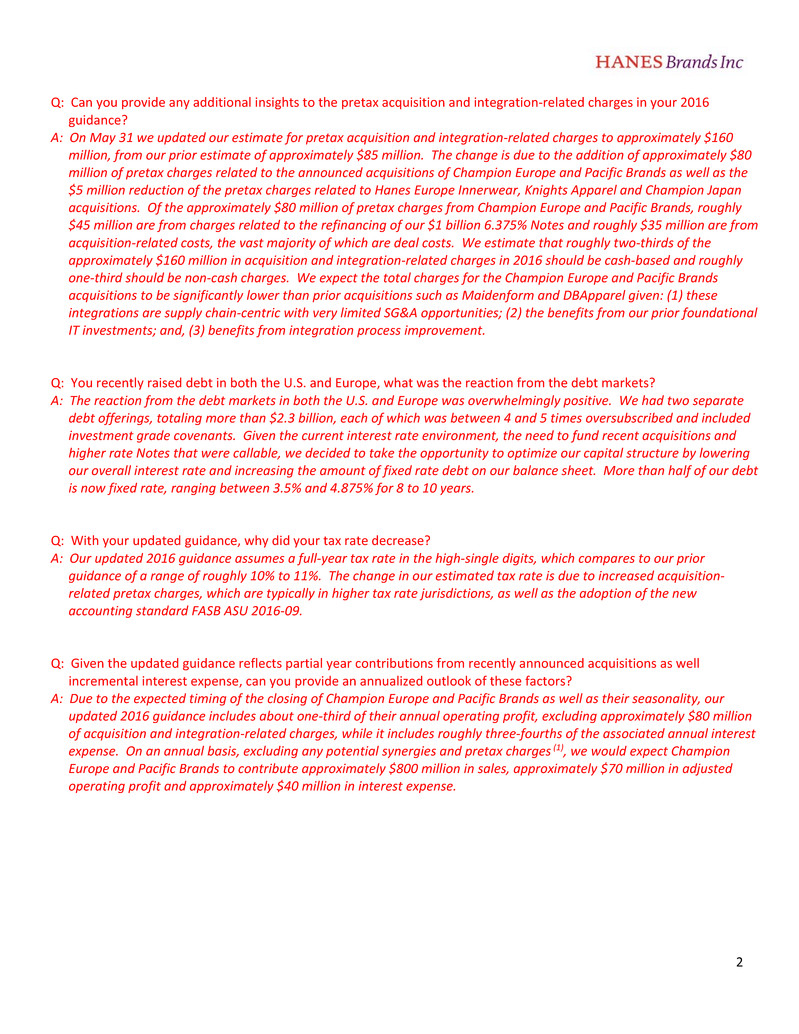
2 Q: Can you provide any additional insights to the pretax acquisition and integration‐related charges in your 2016 guidance? A: On May 31 we updated our estimate for pretax acquisition and integration‐related charges to approximately $160 million, from our prior estimate of approximately $85 million. The change is due to the addition of approximately $80 million of pretax charges related to the announced acquisitions of Champion Europe and Pacific Brands as well as the $5 million reduction of the pretax charges related to Hanes Europe Innerwear, Knights Apparel and Champion Japan acquisitions. Of the approximately $80 million of pretax charges from Champion Europe and Pacific Brands, roughly $45 million are from charges related to the refinancing of our $1 billion 6.375% Notes and roughly $35 million are from acquisition‐related costs, the vast majority of which are deal costs. We estimate that roughly two‐thirds of the approximately $160 million in acquisition and integration‐related charges in 2016 should be cash‐based and roughly one‐third should be non‐cash charges. We expect the total charges for the Champion Europe and Pacific Brands acquisitions to be significantly lower than prior acquisitions such as Maidenform and DBApparel given: (1) these integrations are supply chain‐centric with very limited SG&A opportunities; (2) the benefits from our prior foundational IT investments; and, (3) benefits from integration process improvement. Q: You recently raised debt in both the U.S. and Europe, what was the reaction from the debt markets? A: The reaction from the debt markets in both the U.S. and Europe was overwhelmingly positive. We had two separate debt offerings, totaling more than $2.3 billion, each of which was between 4 and 5 times oversubscribed and included investment grade covenants. Given the current interest rate environment, the need to fund recent acquisitions and higher rate Notes that were callable, we decided to take the opportunity to optimize our capital structure by lowering our overall interest rate and increasing the amount of fixed rate debt on our balance sheet. More than half of our debt is now fixed rate, ranging between 3.5% and 4.875% for 8 to 10 years. Q: With your updated guidance, why did your tax rate decrease? A: Our updated 2016 guidance assumes a full‐year tax rate in the high‐single digits, which compares to our prior guidance of a range of roughly 10% to 11%. The change in our estimated tax rate is due to increased acquisition‐ related pretax charges, which are typically in higher tax rate jurisdictions, as well as the adoption of the new accounting standard FASB ASU 2016‐09. Q: Given the updated guidance reflects partial year contributions from recently announced acquisitions as well incremental interest expense, can you provide an annualized outlook of these factors? A: Due to the expected timing of the closing of Champion Europe and Pacific Brands as well as their seasonality, our updated 2016 guidance includes about one‐third of their annual operating profit, excluding approximately $80 million of acquisition and integration‐related charges, while it includes roughly three‐fourths of the associated annual interest expense. On an annual basis, excluding any potential synergies and pretax charges (1), we would expect Champion Europe and Pacific Brands to contribute approximately $800 million in sales, approximately $70 million in adjusted operating profit and approximately $40 million in interest expense.
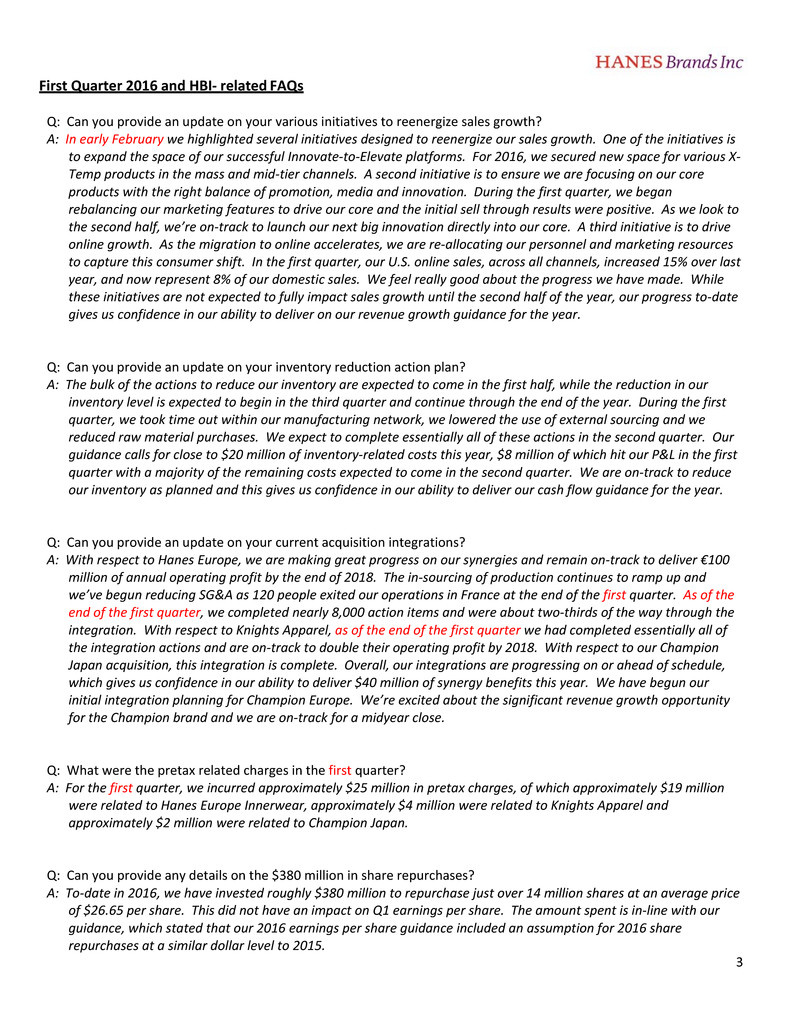
3 First Quarter 2016 and HBI‐ related FAQs Q: Can you provide an update on your various initiatives to reenergize sales growth? A: In early February we highlighted several initiatives designed to reenergize our sales growth. One of the initiatives is to expand the space of our successful Innovate‐to‐Elevate platforms. For 2016, we secured new space for various X‐ Temp products in the mass and mid‐tier channels. A second initiative is to ensure we are focusing on our core products with the right balance of promotion, media and innovation. During the first quarter, we began rebalancing our marketing features to drive our core and the initial sell through results were positive. As we look to the second half, we’re on‐track to launch our next big innovation directly into our core. A third initiative is to drive online growth. As the migration to online accelerates, we are re‐allocating our personnel and marketing resources to capture this consumer shift. In the first quarter, our U.S. online sales, across all channels, increased 15% over last year, and now represent 8% of our domestic sales. We feel really good about the progress we have made. While these initiatives are not expected to fully impact sales growth until the second half of the year, our progress to‐date gives us confidence in our ability to deliver on our revenue growth guidance for the year. Q: Can you provide an update on your inventory reduction action plan? A: The bulk of the actions to reduce our inventory are expected to come in the first half, while the reduction in our inventory level is expected to begin in the third quarter and continue through the end of the year. During the first quarter, we took time out within our manufacturing network, we lowered the use of external sourcing and we reduced raw material purchases. We expect to complete essentially all of these actions in the second quarter. Our guidance calls for close to $20 million of inventory‐related costs this year, $8 million of which hit our P&L in the first quarter with a majority of the remaining costs expected to come in the second quarter. We are on‐track to reduce our inventory as planned and this gives us confidence in our ability to deliver our cash flow guidance for the year. Q: Can you provide an update on your current acquisition integrations? A: With respect to Hanes Europe, we are making great progress on our synergies and remain on‐track to deliver €100 million of annual operating profit by the end of 2018. The in‐sourcing of production continues to ramp up and we’ve begun reducing SG&A as 120 people exited our operations in France at the end of the first quarter. As of the end of the first quarter, we completed nearly 8,000 action items and were about two‐thirds of the way through the integration. With respect to Knights Apparel, as of the end of the first quarter we had completed essentially all of the integration actions and are on‐track to double their operating profit by 2018. With respect to our Champion Japan acquisition, this integration is complete. Overall, our integrations are progressing on or ahead of schedule, which gives us confidence in our ability to deliver $40 million of synergy benefits this year. We have begun our initial integration planning for Champion Europe. We’re excited about the significant revenue growth opportunity for the Champion brand and we are on‐track for a midyear close. Q: What were the pretax related charges in the first quarter? A: For the first quarter, we incurred approximately $25 million in pretax charges, of which approximately $19 million were related to Hanes Europe Innerwear, approximately $4 million were related to Knights Apparel and approximately $2 million were related to Champion Japan. Q: Can you provide any details on the $380 million in share repurchases? A: To‐date in 2016, we have invested roughly $380 million to repurchase just over 14 million shares at an average price of $26.65 per share. This did not have an impact on Q1 earnings per share. The amount spent is in‐line with our guidance, which stated that our 2016 earnings per share guidance included an assumption for 2016 share repurchases at a similar dollar level to 2015.
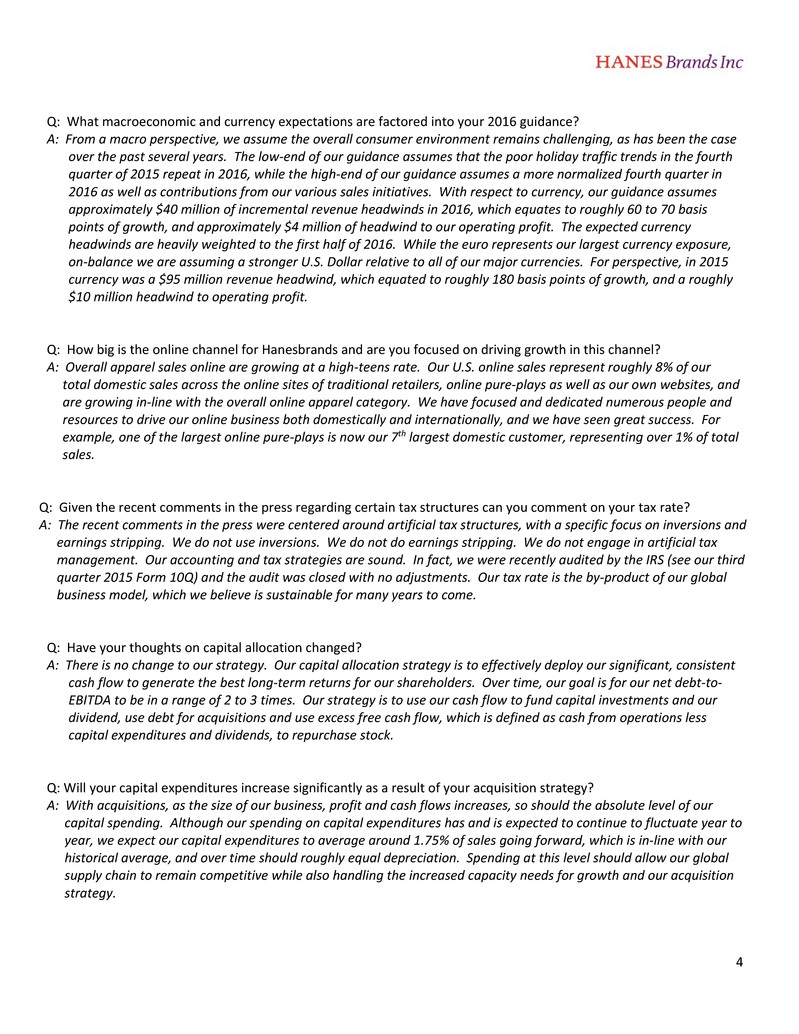
4 Q: What macroeconomic and currency expectations are factored into your 2016 guidance? A: From a macro perspective, we assume the overall consumer environment remains challenging, as has been the case over the past several years. The low‐end of our guidance assumes that the poor holiday traffic trends in the fourth quarter of 2015 repeat in 2016, while the high‐end of our guidance assumes a more normalized fourth quarter in 2016 as well as contributions from our various sales initiatives. With respect to currency, our guidance assumes approximately $40 million of incremental revenue headwinds in 2016, which equates to roughly 60 to 70 basis points of growth, and approximately $4 million of headwind to our operating profit. The expected currency headwinds are heavily weighted to the first half of 2016. While the euro represents our largest currency exposure, on‐balance we are assuming a stronger U.S. Dollar relative to all of our major currencies. For perspective, in 2015 currency was a $95 million revenue headwind, which equated to roughly 180 basis points of growth, and a roughly $10 million headwind to operating profit. Q: How big is the online channel for Hanesbrands and are you focused on driving growth in this channel? A: Overall apparel sales online are growing at a high‐teens rate. Our U.S. online sales represent roughly 8% of our total domestic sales across the online sites of traditional retailers, online pure‐plays as well as our own websites, and are growing in‐line with the overall online apparel category. We have focused and dedicated numerous people and resources to drive our online business both domestically and internationally, and we have seen great success. For example, one of the largest online pure‐plays is now our 7th largest domestic customer, representing over 1% of total sales. Q: Given the recent comments in the press regarding certain tax structures can you comment on your tax rate? A: The recent comments in the press were centered around artificial tax structures, with a specific focus on inversions and earnings stripping. We do not use inversions. We do not do earnings stripping. We do not engage in artificial tax management. Our accounting and tax strategies are sound. In fact, we were recently audited by the IRS (see our third quarter 2015 Form 10Q) and the audit was closed with no adjustments. Our tax rate is the by‐product of our global business model, which we believe is sustainable for many years to come. Q: Have your thoughts on capital allocation changed? A: There is no change to our strategy. Our capital allocation strategy is to effectively deploy our significant, consistent cash flow to generate the best long‐term returns for our shareholders. Over time, our goal is for our net debt‐to‐ EBITDA to be in a range of 2 to 3 times. Our strategy is to use our cash flow to fund capital investments and our dividend, use debt for acquisitions and use excess free cash flow, which is defined as cash from operations less capital expenditures and dividends, to repurchase stock. Q: Will your capital expenditures increase significantly as a result of your acquisition strategy? A: With acquisitions, as the size of our business, profit and cash flows increases, so should the absolute level of our capital spending. Although our spending on capital expenditures has and is expected to continue to fluctuate year to year, we expect our capital expenditures to average around 1.75% of sales going forward, which is in‐line with our historical average, and over time should roughly equal depreciation. Spending at this level should allow our global supply chain to remain competitive while also handling the increased capacity needs for growth and our acquisition strategy.
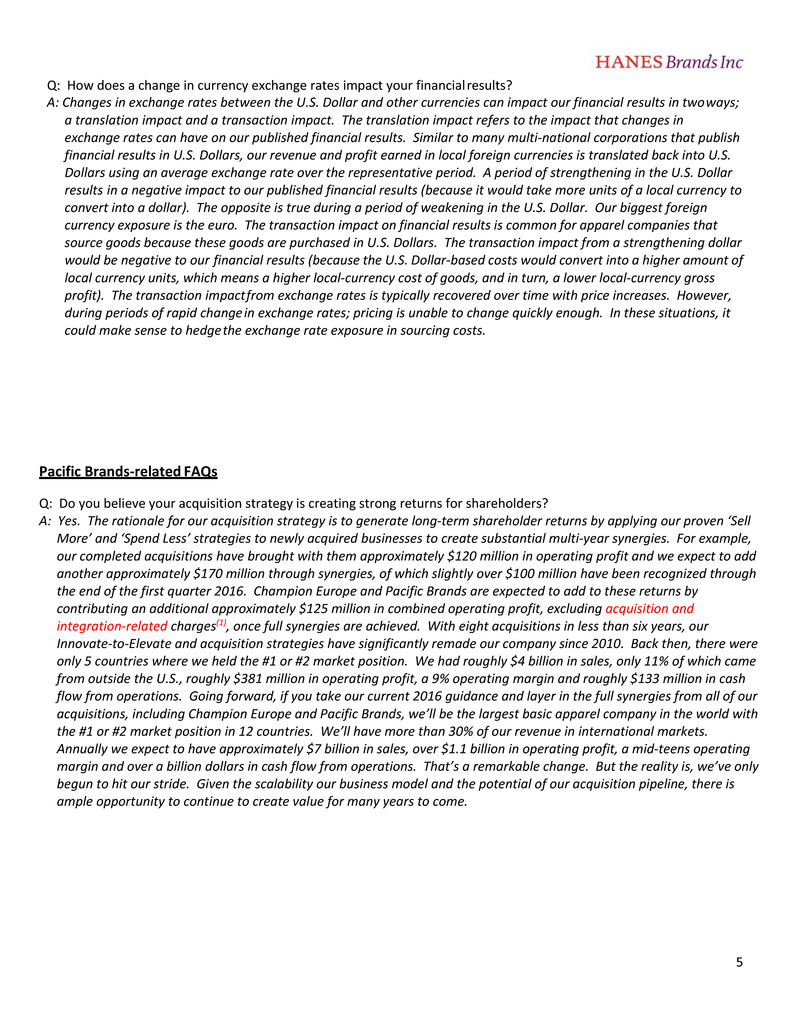
5 Q: How does a change in currency exchange rates impact your financial results? A: Changes in exchange rates between the U.S. Dollar and other currencies can impact our financial results in two ways; a translation impact and a transaction impact. The translation impact refers to the impact that changes in exchange rates can have on our published financial results. Similar to many multi‐national corporations that publish financial results in U.S. Dollars, our revenue and profit earned in local foreign currencies is translated back into U.S. Dollars using an average exchange rate over the representative period. A period of strengthening in the U.S. Dollar results in a negative impact to our published financial results (because it would take more units of a local currency to convert into a dollar). The opposite is true during a period of weakening in the U.S. Dollar. Our biggest foreign currency exposure is the euro. The transaction impact on financial results is common for apparel companies that source goods because these goods are purchased in U.S. Dollars. The transaction impact from a strengthening dollar would be negative to our financial results (because the U.S. Dollar‐based costs would convert into a higher amount of local currency units, which means a higher local‐currency cost of goods, and in turn, a lower local‐currency gross profit). The transaction impact from exchange rates is typically recovered over time with price increases. However, during periods of rapid change in exchange rates; pricing is unable to change quickly enough. In these situations, it could make sense to hedge the exchange rate exposure in sourcing costs. Pacific Brands‐related FAQs Q: Do you believe your acquisition strategy is creating strong returns for shareholders? A: Yes. The rationale for our acquisition strategy is to generate long‐term shareholder returns by applying our proven ‘Sell More’ and ‘Spend Less’ strategies to newly acquired businesses to create substantial multi‐year synergies. For example, our completed acquisitions have brought with them approximately $120 million in operating profit and we expect to add another approximately $170 million through synergies, of which slightly over $100 million have been recognized through the end of the first quarter 2016. Champion Europe and Pacific Brands are expected to add to these returns by contributing an additional approximately $125 million in combined operating profit, excluding acquisition and integration‐related charges(1), once full synergies are achieved. With eight acquisitions in less than six years, our Innovate‐to‐Elevate and acquisition strategies have significantly remade our company since 2010. Back then, there were only 5 countries where we held the #1 or #2 market position. We had roughly $4 billion in sales, only 11% of which came from outside the U.S., roughly $381 million in operating profit, a 9% operating margin and roughly $133 million in cash flow from operations. Going forward, if you take our current 2016 guidance and layer in the full synergies from all of our acquisitions, including Champion Europe and Pacific Brands, we’ll be the largest basic apparel company in the world with the #1 or #2 market position in 12 countries. We’ll have more than 30% of our revenue in international markets. Annually we expect to have approximately $7 billion in sales, over $1.1 billion in operating profit, a mid‐teens operating margin and over a billion dollars in cash flow from operations. That’s a remarkable change. But the reality is, we’ve only begun to hit our stride. Given the scalability our business model and the potential of our acquisition pipeline, there is ample opportunity to continue to create value for many years to come.
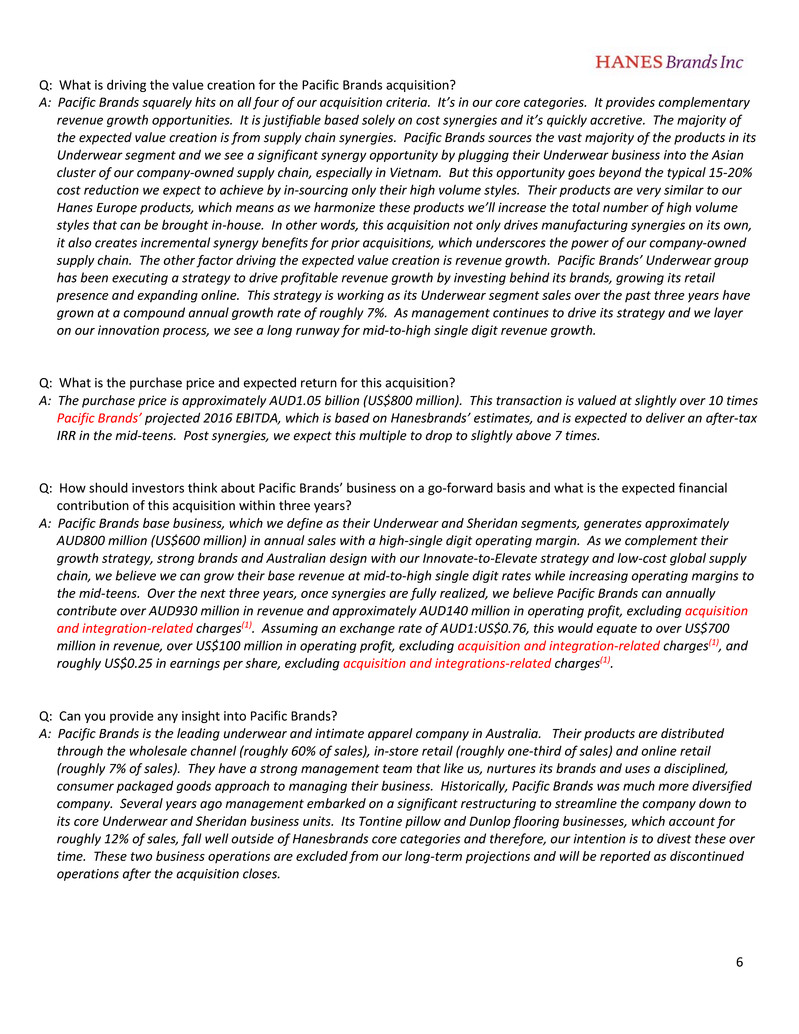
6 Q: What is driving the value creation for the Pacific Brands acquisition? A: Pacific Brands squarely hits on all four of our acquisition criteria. It’s in our core categories. It provides complementary revenue growth opportunities. It is justifiable based solely on cost synergies and it’s quickly accretive. The majority of the expected value creation is from supply chain synergies. Pacific Brands sources the vast majority of the products in its Underwear segment and we see a significant synergy opportunity by plugging their Underwear business into the Asian cluster of our company‐owned supply chain, especially in Vietnam. But this opportunity goes beyond the typical 15‐20% cost reduction we expect to achieve by in‐sourcing only their high volume styles. Their products are very similar to our Hanes Europe products, which means as we harmonize these products we’ll increase the total number of high volume styles that can be brought in‐house. In other words, this acquisition not only drives manufacturing synergies on its own, it also creates incremental synergy benefits for prior acquisitions, which underscores the power of our company‐owned supply chain. The other factor driving the expected value creation is revenue growth. Pacific Brands’ Underwear group has been executing a strategy to drive profitable revenue growth by investing behind its brands, growing its retail presence and expanding online. This strategy is working as its Underwear segment sales over the past three years have grown at a compound annual growth rate of roughly 7%. As management continues to drive its strategy and we layer on our innovation process, we see a long runway for mid‐to‐high single digit revenue growth. Q: What is the purchase price and expected return for this acquisition? A: The purchase price is approximately AUD1.05 billion (US$800 million). This transaction is valued at slightly over 10 times Pacific Brands’ projected 2016 EBITDA, which is based on Hanesbrands’ estimates, and is expected to deliver an after‐tax IRR in the mid‐teens. Post synergies, we expect this multiple to drop to slightly above 7 times. Q: How should investors think about Pacific Brands’ business on a go‐forward basis and what is the expected financial contribution of this acquisition within three years? A: Pacific Brands base business, which we define as their Underwear and Sheridan segments, generates approximately AUD800 million (US$600 million) in annual sales with a high‐single digit operating margin. As we complement their growth strategy, strong brands and Australian design with our Innovate‐to‐Elevate strategy and low‐cost global supply chain, we believe we can grow their base revenue at mid‐to‐high single digit rates while increasing operating margins to the mid‐teens. Over the next three years, once synergies are fully realized, we believe Pacific Brands can annually contribute over AUD930 million in revenue and approximately AUD140 million in operating profit, excluding acquisition and integration‐related charges(1). Assuming an exchange rate of AUD1:US$0.76, this would equate to over US$700 million in revenue, over US$100 million in operating profit, excluding acquisition and integration‐related charges(1), and roughly US$0.25 in earnings per share, excluding acquisition and integrations‐related charges(1). Q: Can you provide any insight into Pacific Brands? A: Pacific Brands is the leading underwear and intimate apparel company in Australia. Their products are distributed through the wholesale channel (roughly 60% of sales), in‐store retail (roughly one‐third of sales) and online retail (roughly 7% of sales). They have a strong management team that like us, nurtures its brands and uses a disciplined, consumer packaged goods approach to managing their business. Historically, Pacific Brands was much more diversified company. Several years ago management embarked on a significant restructuring to streamline the company down to its core Underwear and Sheridan business units. Its Tontine pillow and Dunlop flooring businesses, which account for roughly 12% of sales, fall well outside of Hanesbrands core categories and therefore, our intention is to divest these over time. These two business operations are excluded from our long‐term projections and will be reported as discontinued operations after the acquisition closes.
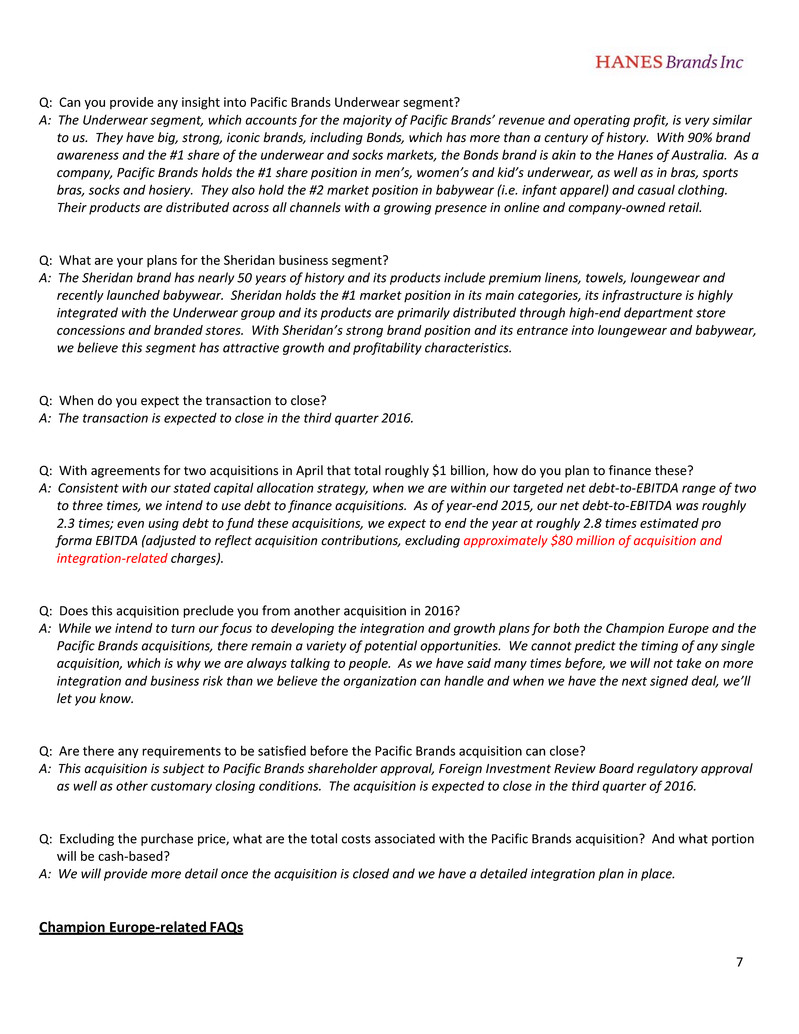
7 Q: Can you provide any insight into Pacific Brands Underwear segment? A: The Underwear segment, which accounts for the majority of Pacific Brands’ revenue and operating profit, is very similar to us. They have big, strong, iconic brands, including Bonds, which has more than a century of history. With 90% brand awareness and the #1 share of the underwear and socks markets, the Bonds brand is akin to the Hanes of Australia. As a company, Pacific Brands holds the #1 share position in men’s, women’s and kid’s underwear, as well as in bras, sports bras, socks and hosiery. They also hold the #2 market position in babywear (i.e. infant apparel) and casual clothing. Their products are distributed across all channels with a growing presence in online and company‐owned retail. Q: What are your plans for the Sheridan business segment? A: The Sheridan brand has nearly 50 years of history and its products include premium linens, towels, loungewear and recently launched babywear. Sheridan holds the #1 market position in its main categories, its infrastructure is highly integrated with the Underwear group and its products are primarily distributed through high‐end department store concessions and branded stores. With Sheridan’s strong brand position and its entrance into loungewear and babywear, we believe this segment has attractive growth and profitability characteristics. Q: When do you expect the transaction to close? A: The transaction is expected to close in the third quarter 2016. Q: With agreements for two acquisitions in April that total roughly $1 billion, how do you plan to finance these? A: Consistent with our stated capital allocation strategy, when we are within our targeted net debt‐to‐EBITDA range of two to three times, we intend to use debt to finance acquisitions. As of year‐end 2015, our net debt‐to‐EBITDA was roughly 2.3 times; even using debt to fund these acquisitions, we expect to end the year at roughly 2.8 times estimated pro forma EBITDA (adjusted to reflect acquisition contributions, excluding approximately $80 million of acquisition and integration‐related charges). Q: Does this acquisition preclude you from another acquisition in 2016? A: While we intend to turn our focus to developing the integration and growth plans for both the Champion Europe and the Pacific Brands acquisitions, there remain a variety of potential opportunities. We cannot predict the timing of any single acquisition, which is why we are always talking to people. As we have said many times before, we will not take on more integration and business risk than we believe the organization can handle and when we have the next signed deal, we’ll let you know. Q: Are there any requirements to be satisfied before the Pacific Brands acquisition can close? A: This acquisition is subject to Pacific Brands shareholder approval, Foreign Investment Review Board regulatory approval as well as other customary closing conditions. The acquisition is expected to close in the third quarter of 2016. Q: Excluding the purchase price, what are the total costs associated with the Pacific Brands acquisition? And what portion will be cash‐based? A: We will provide more detail once the acquisition is closed and we have a detailed integration plan in place. Champion Europe‐related FAQs
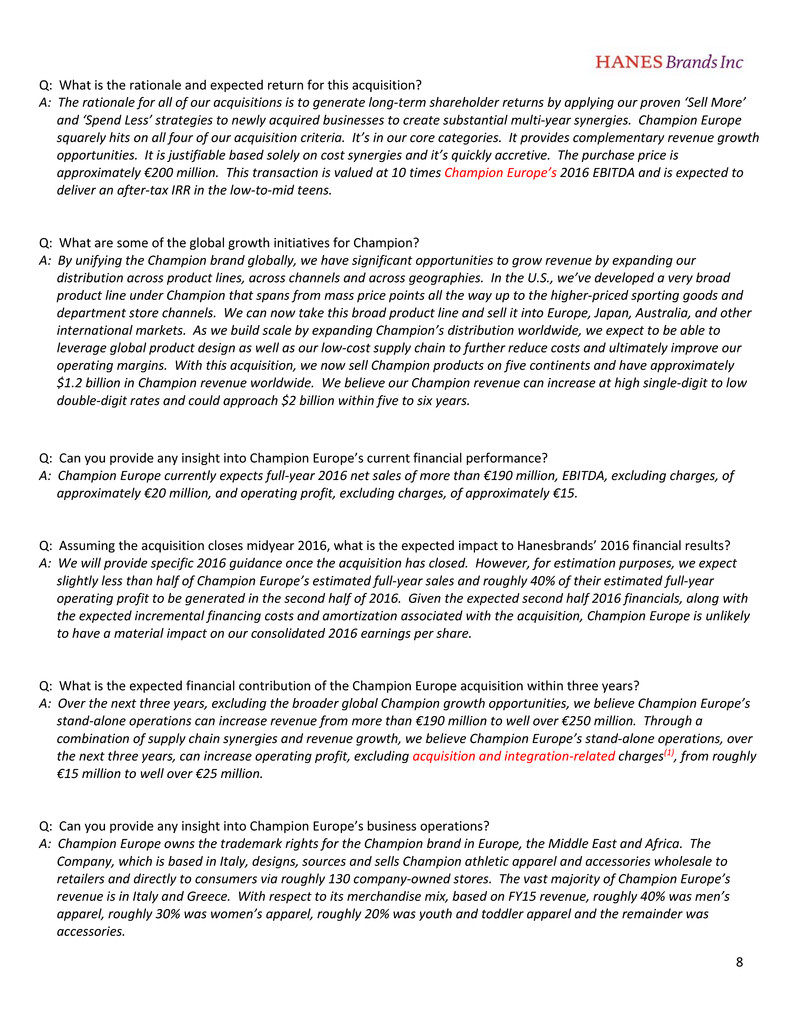
8 Q: What is the rationale and expected return for this acquisition? A: The rationale for all of our acquisitions is to generate long‐term shareholder returns by applying our proven ‘Sell More’ and ‘Spend Less’ strategies to newly acquired businesses to create substantial multi‐year synergies. Champion Europe squarely hits on all four of our acquisition criteria. It’s in our core categories. It provides complementary revenue growth opportunities. It is justifiable based solely on cost synergies and it’s quickly accretive. The purchase price is approximately €200 million. This transaction is valued at 10 times Champion Europe’s 2016 EBITDA and is expected to deliver an after‐tax IRR in the low‐to‐mid teens. Q: What are some of the global growth initiatives for Champion? A: By unifying the Champion brand globally, we have significant opportunities to grow revenue by expanding our distribution across product lines, across channels and across geographies. In the U.S., we’ve developed a very broad product line under Champion that spans from mass price points all the way up to the higher‐priced sporting goods and department store channels. We can now take this broad product line and sell it into Europe, Japan, Australia, and other international markets. As we build scale by expanding Champion’s distribution worldwide, we expect to be able to leverage global product design as well as our low‐cost supply chain to further reduce costs and ultimately improve our operating margins. With this acquisition, we now sell Champion products on five continents and have approximately $1.2 billion in Champion revenue worldwide. We believe our Champion revenue can increase at high single‐digit to low double‐digit rates and could approach $2 billion within five to six years. Q: Can you provide any insight into Champion Europe’s current financial performance? A: Champion Europe currently expects full‐year 2016 net sales of more than €190 million, EBITDA, excluding charges, of approximately €20 million, and operating profit, excluding charges, of approximately €15. Q: Assuming the acquisition closes midyear 2016, what is the expected impact to Hanesbrands’ 2016 financial results? A: We will provide specific 2016 guidance once the acquisition has closed. However, for estimation purposes, we expect slightly less than half of Champion Europe’s estimated full‐year sales and roughly 40% of their estimated full‐year operating profit to be generated in the second half of 2016. Given the expected second half 2016 financials, along with the expected incremental financing costs and amortization associated with the acquisition, Champion Europe is unlikely to have a material impact on our consolidated 2016 earnings per share. Q: What is the expected financial contribution of the Champion Europe acquisition within three years? A: Over the next three years, excluding the broader global Champion growth opportunities, we believe Champion Europe’s stand‐alone operations can increase revenue from more than €190 million to well over €250 million. Through a combination of supply chain synergies and revenue growth, we believe Champion Europe’s stand‐alone operations, over the next three years, can increase operating profit, excluding acquisition and integration‐related charges(1), from roughly €15 million to well over €25 million. Q: Can you provide any insight into Champion Europe’s business operations? A: Champion Europe owns the trademark rights for the Champion brand in Europe, the Middle East and Africa. The Company, which is based in Italy, designs, sources and sells Champion athletic apparel and accessories wholesale to retailers and directly to consumers via roughly 130 company‐owned stores. The vast majority of Champion Europe’s revenue is in Italy and Greece. With respect to its merchandise mix, based on FY15 revenue, roughly 40% was men’s apparel, roughly 30% was women’s apparel, roughly 20% was youth and toddler apparel and the remainder was accessories.
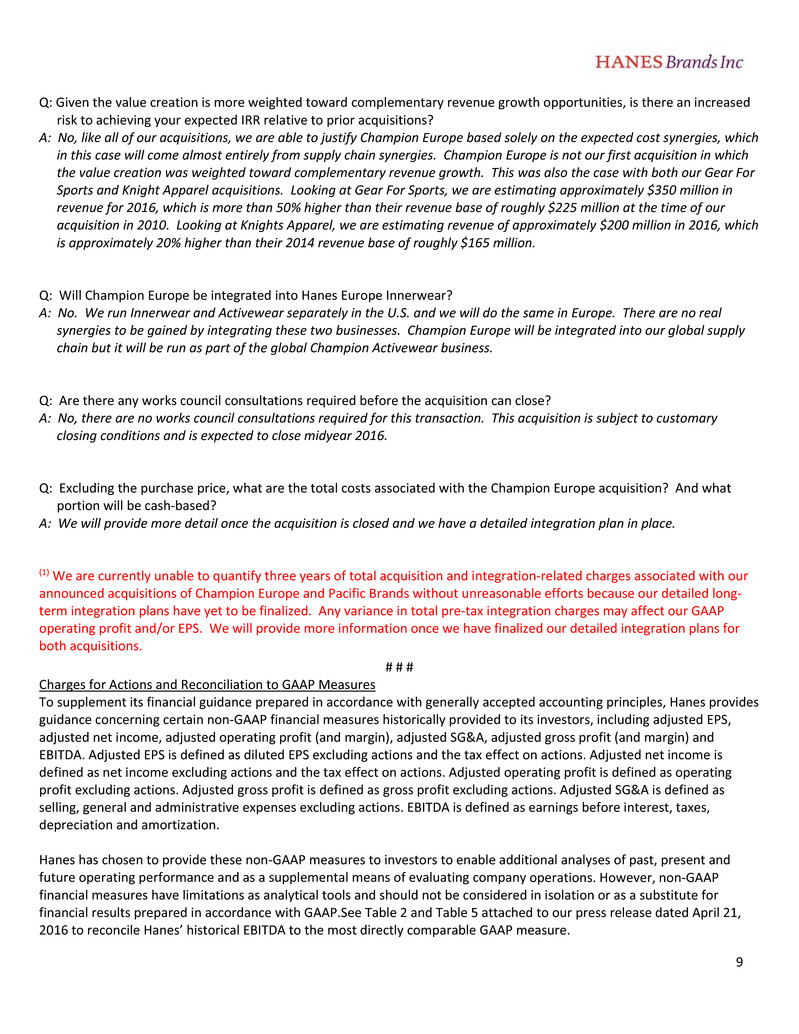
9 Q: Given the value creation is more weighted toward complementary revenue growth opportunities, is there an increased risk to achieving your expected IRR relative to prior acquisitions? A: No, like all of our acquisitions, we are able to justify Champion Europe based solely on the expected cost synergies, which in this case will come almost entirely from supply chain synergies. Champion Europe is not our first acquisition in which the value creation was weighted toward complementary revenue growth. This was also the case with both our Gear For Sports and Knight Apparel acquisitions. Looking at Gear For Sports, we are estimating approximately $350 million in revenue for 2016, which is more than 50% higher than their revenue base of roughly $225 million at the time of our acquisition in 2010. Looking at Knights Apparel, we are estimating revenue of approximately $200 million in 2016, which is approximately 20% higher than their 2014 revenue base of roughly $165 million. Q: Will Champion Europe be integrated into Hanes Europe Innerwear? A: No. We run Innerwear and Activewear separately in the U.S. and we will do the same in Europe. There are no real synergies to be gained by integrating these two businesses. Champion Europe will be integrated into our global supply chain but it will be run as part of the global Champion Activewear business. Q: Are there any works council consultations required before the acquisition can close? A: No, there are no works council consultations required for this transaction. This acquisition is subject to customary closing conditions and is expected to close midyear 2016. Q: Excluding the purchase price, what are the total costs associated with the Champion Europe acquisition? And what portion will be cash‐based? A: We will provide more detail once the acquisition is closed and we have a detailed integration plan in place. (1) We are currently unable to quantify three years of total acquisition and integration‐related charges associated with our announced acquisitions of Champion Europe and Pacific Brands without unreasonable efforts because our detailed long‐ term integration plans have yet to be finalized. Any variance in total pre‐tax integration charges may affect our GAAP operating profit and/or EPS. We will provide more information once we have finalized our detailed integration plans for both acquisitions. # # # Charges for Actions and Reconciliation to GAAP Measures To supplement its financial guidance prepared in accordance with generally accepted accounting principles, Hanes provides guidance concerning certain non‐GAAP financial measures historically provided to its investors, including adjusted EPS, adjusted net income, adjusted operating profit (and margin), adjusted SG&A, adjusted gross profit (and margin) and EBITDA. Adjusted EPS is defined as diluted EPS excluding actions and the tax effect on actions. Adjusted net income is defined as net income excluding actions and the tax effect on actions. Adjusted operating profit is defined as operating profit excluding actions. Adjusted gross profit is defined as gross profit excluding actions. Adjusted SG&A is defined as selling, general and administrative expenses excluding actions. EBITDA is defined as earnings before interest, taxes, depreciation and amortization. Hanes has chosen to provide these non‐GAAP measures to investors to enable additional analyses of past, present and future operating performance and as a supplemental means of evaluating company operations. However, non‐GAAP financial measures have limitations as analytical tools and should not be considered in isolation or as a substitute for financial results prepared in accordance with GAAP.See Table 2 and Table 5 attached to our press release dated April 21, 2016 to reconcile Hanes’ historical EBITDA to the most directly comparable GAAP measure.
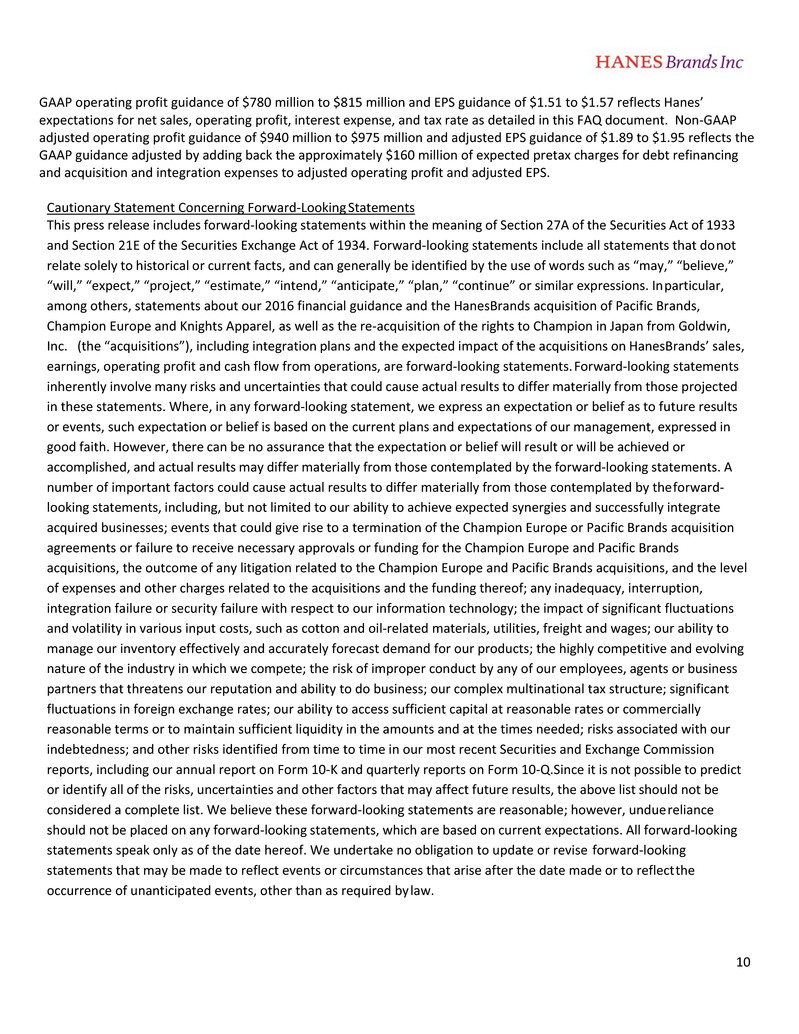
10 GAAP operating profit guidance of $780 million to $815 million and EPS guidance of $1.51 to $1.57 reflects Hanes’ expectations for net sales, operating profit, interest expense, and tax rate as detailed in this FAQ document. Non‐GAAP adjusted operating profit guidance of $940 million to $975 million and adjusted EPS guidance of $1.89 to $1.95 reflects the GAAP guidance adjusted by adding back the approximately $160 million of expected pretax charges for debt refinancing and acquisition and integration expenses to adjusted operating profit and adjusted EPS. Cautionary Statement Concerning Forward‐Looking Statements This press release includes forward‐looking statements within the meaning of Section 27A of the Securities Act of 1933 and Section 21E of the Securities Exchange Act of 1934. Forward‐looking statements include all statements that do not relate solely to historical or current facts, and can generally be identified by the use of words such as “may,” “believe,” “will,” “expect,” “project,” “estimate,” “intend,” “anticipate,” “plan,” “continue” or similar expressions. In particular, among others, statements about our 2016 financial guidance and the HanesBrands acquisition of Pacific Brands, Champion Europe and Knights Apparel, as well as the re‐acquisition of the rights to Champion in Japan from Goldwin, Inc. (the “acquisitions”), including integration plans and the expected impact of the acquisitions on HanesBrands’ sales, earnings, operating profit and cash flow from operations, are forward‐looking statements. Forward‐looking statements inherently involve many risks and uncertainties that could cause actual results to differ materially from those projected in these statements. Where, in any forward‐looking statement, we express an expectation or belief as to future results or events, such expectation or belief is based on the current plans and expectations of our management, expressed in good faith. However, there can be no assurance that the expectation or belief will result or will be achieved or accomplished, and actual results may differ materially from those contemplated by the forward‐looking statements. A number of important factors could cause actual results to differ materially from those contemplated by the forward‐ looking statements, including, but not limited to our ability to achieve expected synergies and successfully integrate acquired businesses; events that could give rise to a termination of the Champion Europe or Pacific Brands acquisition agreements or failure to receive necessary approvals or funding for the Champion Europe and Pacific Brands acquisitions, the outcome of any litigation related to the Champion Europe and Pacific Brands acquisitions, and the level of expenses and other charges related to the acquisitions and the funding thereof; any inadequacy, interruption, integration failure or security failure with respect to our information technology; the impact of significant fluctuations and volatility in various input costs, such as cotton and oil‐related materials, utilities, freight and wages; our ability to manage our inventory effectively and accurately forecast demand for our products; the highly competitive and evolving nature of the industry in which we compete; the risk of improper conduct by any of our employees, agents or business partners that threatens our reputation and ability to do business; our complex multinational tax structure; significant fluctuations in foreign exchange rates; our ability to access sufficient capital at reasonable rates or commercially reasonable terms or to maintain sufficient liquidity in the amounts and at the times needed; risks associated with our indebtedness; and other risks identified from time to time in our most recent Securities and Exchange Commission reports, including our annual report on Form 10‐K and quarterly reports on Form 10‐Q.Since it is not possible to predict or identify all of the risks, uncertainties and other factors that may affect future results, the above list should not be considered a complete list. We believe these forward‐looking statements are reasonable; however, undue reliance should not be placed on any forward‐looking statements, which are based on current expectations. All forward‐looking statements speak only as of the date hereof. We undertake no obligation to update or revise forward‐looking statements that may be made to reflect events or circumstances that arise after the date made or to reflect the occurrence of unanticipated events, other than as required by law.









